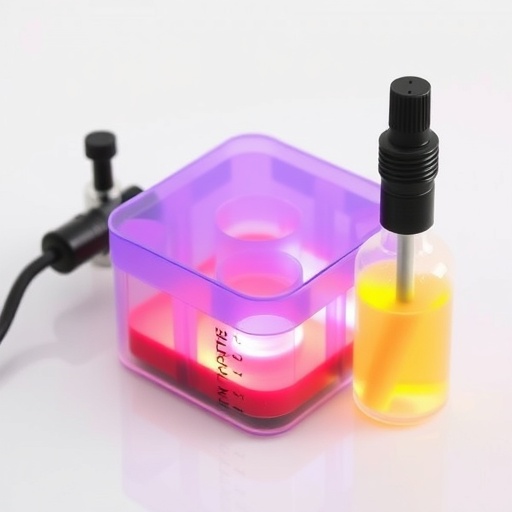In a groundbreaking advancement that promises to revolutionize on-site infectious disease diagnosis and pandemic surveillance, researchers have unveiled a thermally programmed one-pot CRISPR assay designed for rapid, sensitive, and highly specific viral detection. This novel technique, detailed in a recent publication in Nature Communications, integrates thermal programming protocols with CRISPR-based molecular recognition to deliver a streamlined, one-pot diagnostic approach capable of operating outside of centralized laboratory settings. The innovation represents a significant leap toward equitable and scalable testing capabilities, particularly in resource-limited or remote environments where traditional molecular diagnostics face logistical hurdles.
Central to this breakthrough is the ingenious fusion of thermal programming with CRISPR’s precise nucleic acid targeting. By orchestrating the reaction components through carefully controlled temperature stages within a single vessel, the assay coordinates enzymatic amplification with CRISPR-Cas effector activity in a sequential yet seamless manner. This thermal modulation optimizes the sensitivity and specificity of detection while minimizing cross-contamination risks inherent in multi-step assays that require tube transfers or reagent swaps. The one-pot format not only simplifies the workflow but also shortens the time to result, a critical factor in timely public health responses during viral outbreaks.
The scientists behind this innovation highlight the assay’s robust ability to detect viral RNA with high fidelity, even at very low concentrations, due to the synergistic effects of thermal cycling and CRISPR-mediated cleavage. The underlying amplification method is engineered to enrich target sequences under varying temperature conditions, aligning dynamically with Cas protein activation to trigger a definitive fluorescent or colorimetric readout. Such integration assures that the signal is both distinct and reliable, reducing false positives and negatives which have historically challenged rapid diagnostic tests.
From a practical standpoint, the thermally programmed one-pot assay is designed to be deployable in point-of-care settings, requiring minimal instrumentation—a compact thermal cycler or even a portable heating device—and delivering rapid results that can be visually interpreted or measured with simple detectors. This accessibility transforms testing paradigms in outbreak hotspots or underserved communities lacking advanced laboratory infrastructure, enabling health workers to perform on-the-spot diagnostics and make prompt clinical or containment decisions. Early detection facilitates timely isolation and treatment, substantially mitigating disease spread.
The interdisciplinary team engineered the system to be versatile across a spectrum of viral pathogens by modifying the CRISPR RNA guide sequences to match specific viral genomes. This modularity paves the way for quick adaptation when novel viruses emerge or existing variants evolve, an invaluable feature for pandemic preparedness. The assay’s design emphasizes rapid recalibration without sacrificing assay sensitivity, facilitating quick transitions from research to field-ready diagnostics.
Importantly, this diagnostic platform addresses several limitations associated with conventional nucleic acid amplification tests (NAATs) and rapid antigen tests. Traditional NAATs often rely on centralized laboratories, require skilled personnel, and suffer from longer turnaround times. Conversely, antigen tests typically exhibit lower sensitivity, particularly in asymptomatic or early-stage infections. By harnessing the precision of CRISPR and the efficiency of thermally programmed amplification, the new assay bridges this gap, offering a test that is rapid, highly sensitive, and adaptable for diverse operational contexts.
The researchers meticulously validated the assay across multiple viral targets, demonstrating its exceptional analytical performance. Sensitivity benchmarks surpassed those of many existing rapid tests, with the assay detecting target RNA at femtomolar concentrations within 30 to 60 minutes. Specificity assays showed negligible cross-reactivity with non-target nucleic acids, an essential criterion to prevent misdiagnosis during complex epidemic scenarios where co-infections or similar pathogen strains may be present.
Technological nuances of the assay include the utilization of Cas nucleases—CRISPR-associated proteins renowned for their programmable nucleic acid cleavage capabilities. The thermal programming steers the reaction environment, first promoting isothermal or low-temperature amplification stages before elevating temperatures to activate the CRISPR components optimally. This precise thermal choreography underpins the simultaneous yet discrete phases of nucleic acid enrichment and detection, integrated seamlessly within a single reaction tube.
Equally transformative is the assay’s potential role in community-wide surveillance efforts. Implementing this one-pot CRISPR diagnostic as part of routine screening protocols could dramatically enhance the resolution and responsiveness of epidemiological monitoring. Rapid, decentralized testing outcomes enable health authorities to identify infection clusters promptly and implement targeted interventions. In the context of emerging variants with altered transmissibility or vaccine escape properties, such agility is indispensable to mounting effective public health defenses.
Moreover, the assay’s streamlined format drastically reduces costs and logistical demands compared to multi-step laboratory diagnostics. By minimizing reagent transfers and consumable requirements, it curtails biohazard waste generation and reduces reliance on cold chain storage—both crucial factors for sustainability and feasibility in large-scale pandemic responses. This economic advantage aligns with global health priorities advocating for equitable diagnostic accessibility.
The advent of this thermally programmed one-pot CRISPR assay also opens avenues for integration with digital health technologies. Its outputs can potentially interface with smartphone-based readers or portable fluorescence detectors, enabling real-time data capture and remote epidemiological analysis. Such hybridization supports rapid decision-making and resource allocation, vital for areas grappling with infrastructural challenges during health crises.
In conclusion, the thermally programmed one-pot CRISPR assay embodies a paradigm shift in molecular diagnostics. It elegantly combines precision, speed, and operational simplicity, delivering an on-site testing tool that can meet the complex demands of modern pandemic control. Its scalability and adaptability promise a new era where rapid detection of viral pathogens is not a limiting factor in outbreak management but a readily available asset empowering communities worldwide. As the scientific community continues to refine this platform and expand its applications, the prospect of curbing future pandemics with swift, accessible diagnostics appears more attainable than ever before.
Subject of Research: Thermally programmed one-pot CRISPR assay development and its applications in pandemic surveillance.
Article Title: Thermally programmed one-pot CRISPR assay for on-site pandemic surveillance.
Article References:
Huang, Z., Dong, Y., Yang, Y. et al. Thermally programmed one-pot CRISPR assay for on-site pandemic surveillance. Nat Commun 16, 10286 (2025). https://doi.org/10.1038/s41467-025-65193-1
Image Credits: AI Generated
DOI: https://doi.org/10.1038/s41467-025-65193-1
Tags: CRISPR-based molecular recognitionenhancing sensitivity and specificityequitable testing capabilitieson-site viral detectionone-pot CRISPR assaypandemic surveillance technologypublic health response innovationsrapid infectious disease diagnosisresource-limited environmentsstreamlined workflow for diagnosticsthermal modulation in diagnosticsthermally programmed diagnostic technique





